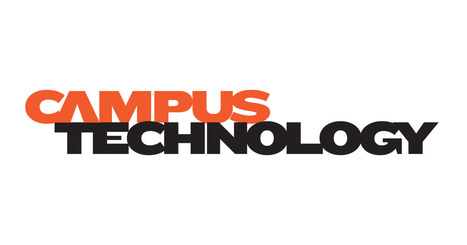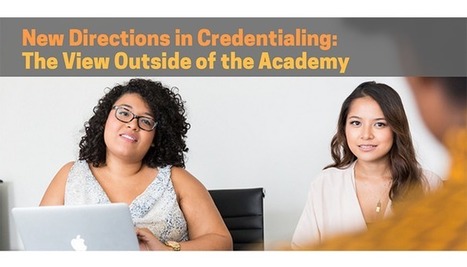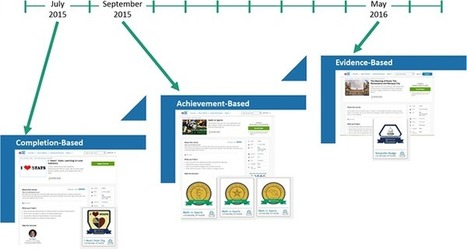 Your new post is loading...
 Your new post is loading...
Echo360 is adding new tools to assess learning and measure student engagement in continuing education programs, thanks to the acquisition of online learning company Astute Technology.
Leaders from Learning Machine, MIT Media Lab, and Carnegie Mellon University engaged in a groundbreaking conversation with a packed house of EdTech vendors and education leaders at the annual EDUCAUSE conference. Together, they introduced Blockcerts, the open standard for issuing secure, verifiable digital credentials.
Hosted by Learning Machine CEO, Chris Jagers, the panel brought together research from the MIT Media Lab (Principal Engineer Kim Duffy), real-world perspective from the Registrar of Carnegie Mellon University (John Papinchak), implementation details from Learning Machine leadership (COO Dan Hughes), and the societal implications of distributed technologies (Learning Machine Anthropologist Natalie Smolenski). The panelists described a future in which learners are able to act as their own lifelong registrars with blockchain credentialing.
Chris Jagers began the discussion by acknowledging the uncharacteristic interest in this new technology from universities worldwide: “There’s been a lot of genuine excitement about using the blockchain within higher education because the promise is immense. The promise is that it will enable students to hold and share their own official records directly with others in a manner that is safe, tamper-proof, and trusted. We’re talking about degrees, transcripts, certifications, badges–everything.”
Educators are always learning. In the classroom with students, at workshops and trainings, through the process of developing and facilitating lessons, and in so many more places educators are constantly building and refining their skills. Often, the skills developed in their day-to-day practice prove to be the most valuable tools for educators. With micro-credentials, educators can now be formally recognized for the skills and competencies they learn throughout their careers. Micro-credentials are research-backed, expert-assessed, representations of learned skills or competencies that can be presented as a digital badge. In partnership with Digital Promise and their micro-credential platform, Maker Ed is excited to share “Getting Started with Making,” a set of six maker education micro-credentials.
Great in depth dive into soft-skills and how to prepare students and getting them job ready on a much more granular way. Great comparison between competencies and capabilities.
A series of specific designed courses, coupled with badges and gaming, helps students in Northern Ireland to master the skills they need to be ready for the workforce. The South West College team share their story.
The South West College is at the heart of the communities of Tyrone and Fermanagh. Physically represented at campuses in Cookstown, Dungannon, Enniskillen and Omagh, the College employs over 500 full time and part time staff servicing some 14,000 enrolments with a turnover of £40m and makes a major contribution to the local and regional economy.
In order to boost students’ employability, the South West College have introduced a new student enhancement initiative called the “SWC Virtual Academy” which is student-centered, interactive, engaging and available 24/7.
Institutions of higher education are starting to experiment with new forms of credentialing. Where (if at all) do future employers factor into the process?
Institutions of higher education are starting to experiment with new forms of credentialing. The more ambitious are looking at developments in competency-based learning (CBE) and building programs in that model, which recognize learning achievements in new ways, from extended digital transcripts (the retrospective view) to digital badges (a prospective view).
Interest in this is becoming clearer as the signaling value of student’s experience in higher education is collapsing to a single variable: the brand of the institution. It’s a rich irony that in the era of exponentially increasing amounts of data, that which appears to be most salient to the performance of companies depending on new hires is contained in logo of their school.
To make Competency X a success, it was vital that we know which foundational science-based skills industry partners seek in employees and interns. We co-created the badges in a Summer Workshop with teachers, scholars, and industry and college partners who collaborated to ensure that scholars are focused on the most important skills, knowledge, and dispositions for success. Together, we identified high-demand and foundational science-based skills. For example, dispositions like humility, independence, and persistence were proposed alongside more traditional science-based practices in NGSS like analyzing data or engaging in argument. We used this rich information, as well as teacher proposed learning progressions on science and engineering practices to build digital badges that validate mastery of skills and practices.
If teachers are expected to design and build innovative learning cultures for their students, it is critical that they learn in trusted spaces that allow them to experiment and fail.
Teachers should be able to choose learning pathways that build upon their existing knowledge, experiences and interests, and support their goals for their students. Most importantly, if teachers are expected to design and build innovative learning cultures for their students, it is critical that they learn in trusted spaces that allow them to experiment and fail.
In recent years, disruptive technologies that support alternative credentialing (e.g., digital badges) have introduced the possibility of transitioning to a competency-based system for professional learning. However, a systemic overhaul is necessary for these new micro-credentialing systems to work, allowing districts and teachers to recognize the value of badges to demonstrate the implementation of professional learning — a critical component for effective PD.
Currently, most badges and/or micro-credentials equate to Continuing Education Units (CEUs) and these, in turn, equate to seat time. This is an important first step, but cannot be the only step. Badges and micro-credentials should unlock further learning opportunities and be awarded based on competency. Most importantly, they need to provide teachers with more benefits than a CEU credit hour, which is received at a traditional workshop with little demonstration of learning outcomes or implementation in the classroom.
Professional development should focus on providing teachers with support, research and tools that allow them a choice in what they make, and how they demonstrate the teaching and learning that best reflects the complexity of these processes.
Oregon Tech Online is currently offering more than 20 badges in several areas, including Healthcare and Information Technology, but any course, series or courses, or assessment-based offering at the institution is "badge-able." For instance, "It is possible to develop a badge for an exam, an award, successful completion of a coding 'boot camp,' or to reflect a specific skill set students may achieve at a certain point in their college career," according to a statement from the school. Badges are awarded for "excelling enough to be deemed proficient at the skill," and can be stacked to show specializations.
Awarded electronically, the badges can be displayed on LinkedIn, social media, e-portfolios, electronic resumes, websites or other formats. Each badge is linked to a specific skill set and verified by Oregon Tech, allowing potential employers to view a student's capabilities without having to obtain transcripts. Badges are tagged so that they can be searched by skill area. Employers can even work with the university to design badging "groups" that identify step raises or advancement opportunities for employees.
This episode contains a brief discussion with Lawrence Lundy about the blockchain and the future of education. Lawrence is the Head of Research and Partnerships at Outlier Ventures.
1. How do you define the blockchain and these related technologies? How do you see it relating to AI, IoT, and other technologies?
2. You indicated in your Medium post that you believe blockchain technologies present “the most significant democratizing force in history.” What do you see about the current and future trends in blockchain and related technologies has you this excited?
3. What challenges and opportunities do you see in blockchains as they relate to the field of education?
4. What elements of the work that we’re doing in badgechain excites you?
A keynote presentation at the University of Worcester's Staff Development Day (16 November 2015)
Abstract
One of the most promising educational technology tools, open digital badges, is quickly changing curricula, job acquisition, and workforce credentialing. Learning data, assessments, and expert validation made accessible in social media create a transparency that may well be suited for critical questions in education. Operating from a framework of establishing how badges are currently employed in learning—the influential contexts of individuals and communities, and data aggregation—raises questions concerning the roles of instructors, badge providers, and learning management systems. This “philosophy” of digital badges addresses a variety of epistemological concerns including the intersection of challenges to conventional educational motivation, suggestions of how Platonic and modern models of education are complementary, and implications of how badges may represent postmodern credentialing systems. These concerns are framed around understanding how current work in digital badges can feasibly transform learning; this is both an acknowledgment of how badges are beginning to change ecosystems of informal and formal learning as well as an attempt to demonstrate how an epistemological philosophy of badges can change educators’ thinking and accelerate innovation.
Preface
Digital Badges represent a valid indicator of specific achievements, knowledge, skills, and competencies that can be earned in formal and informal learning environments. Digital Badges represent an opportunity to recognize such achievements through credible organizations that can be integrated in traditional educational pro-grams but can also represent experience in informal contexts or community engagement. Furthermore, instructional designers can use badges to motivate and influence engagement by providing for example focused goals or challenging tasks.
Digital Badges are a relatively new technology and therefore acceptance depends on the level of quality control, the actual design, and implementation in learning environments. They offer a form of recognition of learning, with a focus on qualifications like problem-solving, self-management, flexible, and individual learning achievements, and provide information to relevant stakeholders when they are digi-tally linked with user profiles or shared in social networks. But implementing digital badges in learning environments can be challenging, because different forms of assessment require new forms of instruction and a clear understanding of learning outcomes.
This edited volume aims to provide insight into how digital badges may enhance formal and informal education by focusing on technical design issues including organizational requirements, instructional design, and deployment. It features cur-rent research exploring the theoretical foundation and empirical evidence of the utilization of digital badges as well as case studies that describe current practices and experiences in the use of digital badges for motivation, learning, and instruction in K-12, higher education, workplace learning, and further education settings.
|
Key Takeaways
Over the past year, the University of Notre Dame's Kaneb Center for Teaching & Learning and the Office of Digital Learning designed five different Credly Open Badges across three edX MOOCs and issued them to 233 learners around the globe.
Each MOOC for which the team piloted badges had different goals and requirements for awarding badges, and each pilot taught the team different lessons about the badges' value to students.
Analysis of the data gathered for each pilot helped the team settle on recommendations for future use of badges in MOOCs.
It seems that digital badges are everywhere these days: in fitness apps, on social networking websites, and in company loyalty programs. In higher education, they're taking the form of microcredentials, representing successful completion of a variety of learning experiences inside and outside of the traditional for-credit course.
Institutions continue to experiment with digital badges, and the rate of adoption is increasing at a rapid pace. According to a recent study of 190 institutions by the University Professional Continuing Education Association (UPCEA), one in five colleges has issued digital badges.
About CreateWorld
We’re thrilled to announce that CreateWorld is back for another year and will be held at Griffith University’s Brisbane South Bank campus on 8-9 December, 2016.
CreateWorld is our 2 day performance, presentation, and professional development event, specifically for academic and technical staff who work in the digital arts disciplines.
Current developments in computing all address in different ways extended presence made possible by new technological platforms—cloud computing, virtual reality, the Internet of Things. For CreateWorld 2016 we will take a closer look at how the simple life of objects, and the ways in which humans interact with them, is being reimagined by current practitioners in the overlapping fields of technology, art, and design.
The conference features a wide range of academic and technical presenters from the tertiary education and industry sectors, and includes several keynotes, panel sessions, hypotheticals, hands-on technical workshops, and regular presentation sessions.
Mozilla Foundation and Collective Shift/LRNG to Transition Management of the Popular Open Badges Project to IMS Global to Ensure Long-term Support and Sustainability
LAKE MARY, Florida, 28 October 2016 – IMS Global Learning Consortium (IMS Global/IMS), the world leader in EdTech interoperability and innovation, the Mozilla Foundation, and Collective Shift/LRNG announced today an agreement for IMS Global to become the organization responsible for advancing the development, transferability, and market adoption of the Open Badges specification beginning January 1, 2017. As an open-governance, member-based standards consortium, IMS Global is committed to furthering the adoption, integration, and portability of digital badges to meet the needs of learners, educators, and employers.
The University of Texas System is updating its technology learning platform to one that features an online marketplace of courses and credentials, real-time feedback and personalized student support services.
UT System’s Institute for Transformational Learning will work with Salesforce and Salesforce.org, the philanthropic arm of Salesforce, to help establish the 2.0 version of TEx (Total Educational Experience).
TEx will fall under the Institute for Transformational Learning’s portfolio of initiatives that aim to leverage new technologies and innovative programs to benefit students. That portfolio has been dubbed UTx.
Unlock the potential of badge applications
Next webinar is on Monday 10 October at 15:00 / 3pm CEST (14:00 / 2pm BST).
Welcome to our very first OBF Academy webinar of fall 2016! In this webinar, we will go through some of the most recent features that have been added to OBF.
The emphasis will be on badge applications and on the different ways on how to evaluate them (for example peer assessment). Badge applications feature is one of the most used feature in Open Badge Factory. Make sure you join us and learn more!
Got questions you want to send in before the webinar? Tweet us at @OBFactory_.
How to join:
Go here: discendum.adobeconnect.com/OBFAcademy
Choose “Enter as a Guest”
Write your name
Click “Enter Room”
Welcome!
We need to move toward student ownership of the transcript with institutional stewardship, based on new design principles.
Unbundling doesn’t mean liberal arts will disappear. It may be that liberal arts courses provide high-value competencies that predict career success across many professions. But it does mean that revenue per student will decline, and that colleges and universities will need to work a lot harder and be a lot more creative to capture the lifetime value of student-consumers. No longer will students fork over $200,000 in tuition for a standard four-year bundle. Postsecondary education will become increasingly affordable. Completion rates will rise. Placement will improve. This is how technology will ultimately disrupt higher education.
While this seems like the stuff of science fiction, it is not far off. Millions of new job descriptions are posted online every month. Colleges and universities are issuing millions of micro-credentials, millions of students are posting work in e-portfolios. Thousands of employers use Applicant Tracking Systems that are transitioning to Applicant Information Systems.
Last week, I wrote about the need for stackable global credentials in order to meet the quickly growing international demand for higher education. Globally, the lack of interoperability standards between alternative and traditional educational systems may be the single most significant barrier to making education accessible to the poor, particularly in the developing world.
How might an interoperable educational system work? To imagine such a system, we need to understand how the parts of the system ought to fit together—much like Legos do. In the traditional educational system, degrees are monolithic bundles similar to Tonka trucks that cannot easily be broken into components unlike a Lego truck that can be broken into components and reassembled into different combinations. If there were interoperable standards in education, like there are Lego blocks, the system would give way to a variety of educational products: people could buy individual lessons or courses (individual Lego blocks); purchase modular degrees, certifications, and other learning bundles (Lego kits); or attend comprehensive modular universities (Lego cities).
Companies around the world are exploring blockchain, the technology underpinning digital currency bitcoin. In this Blockchain unleashed series, we investigate the many possible use cases for the blockchain, from the novel to the transformative.
Most people agree we do not need to know how a television works to enjoy using one. This is true of many existing and emerging technologies. Most of us happily drive cars, use mobile phones and send emails without knowing how they work. With this in mind, here is a tech-free user guide to the blockchain - the technology infrastructure behind bitcoin, and many other emerging platforms.
What does the blockchain do?
The blockchain is software that stores and transfers value or data across the internet.
To thrive in today’s fast-evolving job market, students need flexible ways to quickly develop and demonstrate new skills. Alternative credentialing helps solve this problem.
UPCEA and Pearson surveyed 190 institutions to determine the role alternative credentials play in higher education. Learn more about the key findings and download the complete report, Demographic Shifts in Educational Demand and the Rise of Alternative Credentials.
The blockchain technology we use to store all of our data and projects allows community partners and leaders we trust to review our portfolios (anonymously, or course), and give us feedback and rate our competencies, which add up to badges, which add up to credentials. To me, that's much more useful and reliable than a teacher giving me a grade. UA's competency trackers are always adding new experiences in the database, which helps us find vetted learning experiences that can help us build whatever skills we need; that's how we found the Toastmasters coaches. We have no trouble finding what we need to learn, especially with how much is on the Internet.
|
 Your new post is loading...
Your new post is loading...
 Your new post is loading...
Your new post is loading...






























